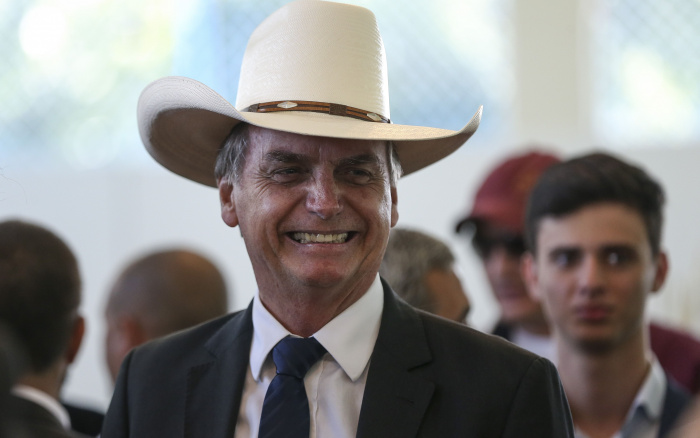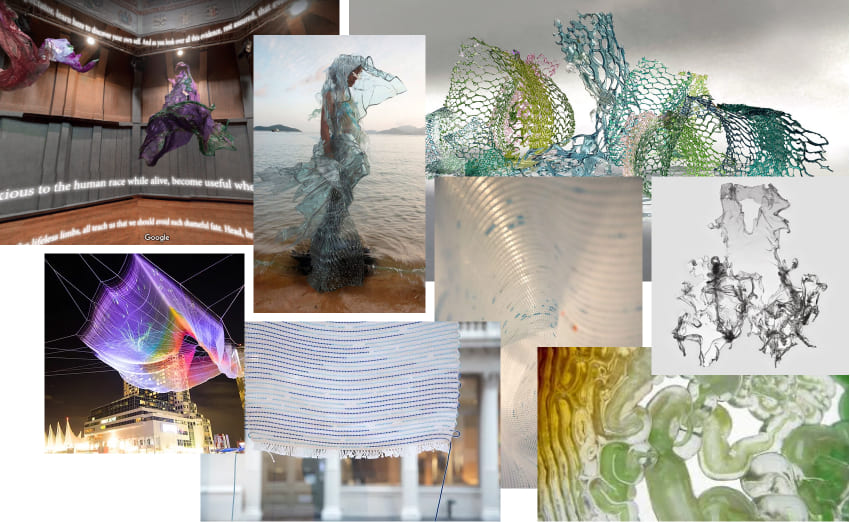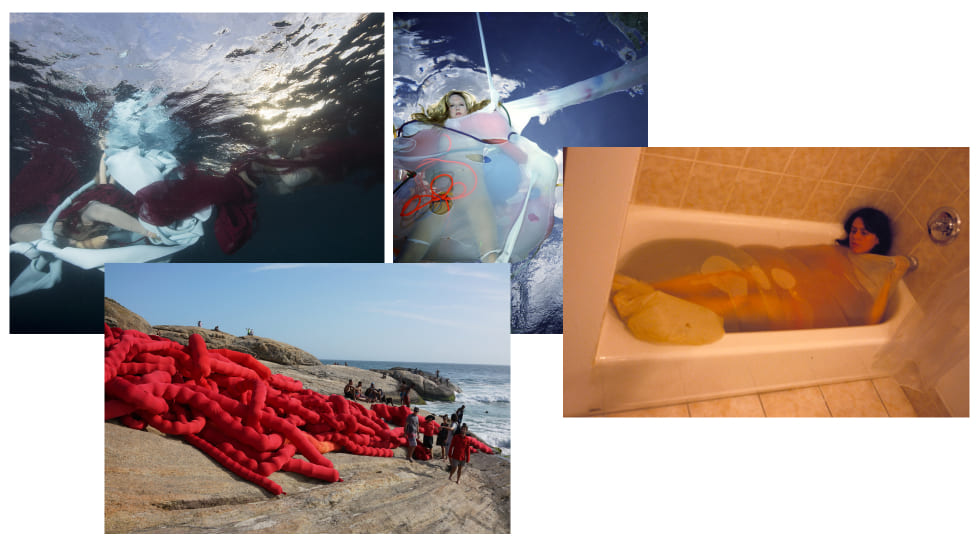RESEARCH¶
During the holidays and the resumption of classes in January, I realized something: to question the issue of water in Brazil and make a product that indicates the pollution of the country's waters, I need to have ownership of what I'm going to say and responsibility on the matter. So, I researched about water, its history in Brazil and the various issues that permeate the subject.
ABOUT WATER IN BRAZIL¶
general scope¶
Brazil has the largest freshwater reserve in the world and concentrates about 13% of the available volume on the planet (MATIAS, - ; IBGE, 2021), of which a good part is in underground aquifers and another part in hydrographic basins (IBGE, 2021).

image from here
My focus for this project will be on the hydrographic regions and watersheds of the country:
Watersheds consist of the land surface that captures rainwater (river, stream or stream) and over which the water flows, forming rivers and streams that drain to a common outlet, at a lower point of relief (IBGE, 2021). So, they are a large area in which a main river is fed by other rivers around it, the tributaries (MATIAS, -).
A hydrographic region is considered to be the Brazilian territorial space comprising a basin, or a group of basins or continuous hydrographic sub-basins with homogeneous or similar natural, social and economic characteristics, in order to guide the planning and management of water resources. (IBGE, 2021).
Brazil's hydrographic basins (MATIAS, -):
- Amazon River Basin;
- Tocantins-Araguaia Hydrographic Basin;
- São Francisco Watershed;
- Platinum Basin (Paraná, Paraguay and Uruguay Basins);
- Parnaíba Hydrographic Basin;
- East Northeast Atlantic Hydrographic Basin;
- West Northeast Atlantic Hydrographic Basin;
- East Atlantic Watershed;
- Southeast Atlantic Hydrographic Basin;
- South Atlantic Hydrographic Basin;
Hydrographic Regions of Brazil:
- Amazon Hydrographic Region
- East Atlantic Hydrographic Region
- Southeast Atlantic Hydrographic Region
- West Northeast Atlantic Hydrographic Region
- East Northeast Atlantic Hydrographic Region
- Tocantins – Araguaia Hydrographic Region
- Parnaíba Hydrographic Region
- São Francisco Hydrographic Region
- South Atlantic Hydrographic Region
- Paraguay Hydrographic Region
- Paraná Hydrographic Region (region where I live :))
- Uruguay Hydrographic Region

image from here
On the government website you can find the archives of Brazilian hydrographic basins:

About 80% of the country's surface water is found in the Amazon Hydrographic Region, which has low population density and little demand for water use (BRAZIL, 2020). However, because of a phenomenon called ecological connectivity, the alteration of an element (for example, fires in the Amazon) can cause changes in the dynamics of other natural agents and watersheds (such as rains in the south of the country and subsequent droughts)(AGUILERA, 2021c).
This explains the importance and dynamics of the waters of the Amazon, as shown in this video made by Google Earth.
the video appears in Portuguese, but it is possible to find it in English as well
environmental scandals and crimes¶
When we think about the Amazon, unfortunately we associate the territory with environmental crimes.
An example is the pace of destruction caused by illegal mining that has exploded in Brazil in recent years due to the change in the forest code in 2012 under Dilma's government, subsequent administration of Michel Temer (2016-2018) and current presidency of Jair Bolsonaro.
Thus, since 2016, at least 632 kilometers of rivers in indigenous lands in the Amazon have been devastated. In addition, illegal gold (90% originating in the Amazon) exploited between 2019 and 2020 in Brazil caused a socio-environmental damage of about R$31.4 billion (MODEFICA, 2021).

image from here by Chico Batata for Greenpeace
But scandals involving waters involve basins across the country for several reasons at the same time. Another example is the conflicts over water in the semi-arid region of Minas Gerais due to mining(AGUILERA, 2022). In this extractive activity, water is a fundamental element, which ends up generating disputes over water in the region where it is installed. Currently, the state of Minas Gerais has 25 dams in a state of alert and 117 conflicts caused by national or international mining companies, while the state of Bahia has 33 cases linked to the activity.

Two emblematic examples of environmental crime were the ruptures of the dams of the Vale do Rio Doce company in Mariana (2015) and Brumadinho (2019), in which the ruptures compromised part of the region's watershed and caused the population to become ill (AGUILERA, 2022).
Even so, the company Samarco (or Vale do Rio Doce, or BHP) resumed its activities in Mariana without paying for the burden incurred in the region. In addition, shareholders had a financial return after the tragedy, since after the disaster, the mining company has been announcing the return as "a salvation for Mariana" and positioning itself as a "cleaner" company, which "revamped itself" and now will make "a new mining" through speeches made up with greenwashing (SATROPASOLAS, 2020).

Hydroelectric plants also surround water problems in Brazil, such as the Uruguay Basin in the south of the country.
According to Bastos (2021) the region is considered an important biodiversity corridor, however it suffers the incessant action of pesticides and agro-industry residues, receives tons of industrial waste and has been harassed by decades of silting, deforestation and the works of hydroelectric plants that go on without stopping. The author also points out that in the 384 Brazilian municipalities covered by the Uruguay Hydrographic Region, sanitation is precarious and, in many cases, non-existent.

image from here
Even so, its situation could worsen considerably, if the federal government (via Eletrobras) goes ahead with the proposal to build the Binacional Hydroelectric Complex Garabi-Panambi (BASTOS, 2021). In addition, the work can expel residents from the region without providing counterparts (BASTOS, 2021).
According to the state coordinator of the Movement of People Affected by Dams (MAB), Tereza Pessoa, dams are not built to serve the local population, but to achieve the goals of foreign capital (BASTOS, 2021).
In addition, for the hydroelectric reservoir to function, a large artificial lake must be built. Thus, the climate changes, the death and disappearance of species occurs, the eviction of residents of the region and the disappearance of natural landscapes. An example was the 7 waterfalls (7 Quedas) in the state of Paraná (where I live), at the time of the construction of the Itaipu Hydroelectric Power Plant.

Basic sanitation is also another problem in Brazil, an example is the Caminho da União occupation in Baixada Santista (SP) in the southeastern region of the country, where the occupation grew and lost control of the community's access to water. According to the following documentary (in Portuguese), in Brazil there are 35 million people without access to drinking water and 100 million without sewage treatment.
The documentary is in Portuguese, but it is possible to see the basic sanitation condition of some regions of the country through the images that appear in the film.
historical overview of the organizational field of Brazilian waters¶
The article by Costa, Vizeu and Guarido Filho (2016) shows an important historical overview of the organizational field of Brazilian waters:
There was a consensus that water was an infinite and inexhaustible resource. This marked the incorporation of Brazil into the European mercantile economic system, since during the colonization period the territory was considered an inexhaustible source of natural resources, violently ignoring any form of community that already existed in the region.
In this way, water legislation in an institutional way only starts to matter in the country when the royal family moves here (1808), at that time the factor of transport through water is quite relevant for the formulation of laws.

The authors show that later, in a pre-republic period, the agrarian elite achieved autonomy from the Institutions and began to articulate its factor. This explains a lot about how water is currently treated in the country, since the main use of water, in terms of quantity used, is irrigation (BRASIL, 2020).
And in the field of regulatory interests, Brazil's hydro-energy potential has great weight. Thus, the first legislation involving water in the country emerged in order to protect private investments for the generation of electric energy, since water is a resource considered fundamental for the development of the growing industrial activity. So, the first regulations (1916) mark a period of initial industrialization in the country in which water is considered a private good.
It was in the 70's that the degradation of water resources by urban and industrial waste began to worry society and the moves for effective legislation on the subject began.
Here we can point out: the water problem in Brazil is structural and has its origins in colonization. The developed countries of the North are historically responsible for climate change, but face the lowest risk of extreme effects. Commodities are exported mainly to European countries, China and the United States. For countries in the Global South such as Brazil, damage remains, such as droughts and changes in rainfall, while pesticides sold by the same countries contaminate rivers, soil and the local population (AGUILERA, 2021b).
This makes sense when we think about environmental racism, in which most of the population affected by the lack of basic sanitation and climate change in the country are black people. In this way, they (with indigenous people) have been placed on the margins of society since the period of colonization/imperialism and continues to this day.
 image from here, by Coalizão Negra por Direitos
image from here, by Coalizão Negra por Direitos
environmental setbacks, threats and the Bolsonaro government¶
One of the first threats of the Bolsonaro government was to extinguish the Ministry of the Environment (MMA) and incorporate its actions into the Ministry of Agriculture. This did not happen due to popular pressure, but the MMA lost political power and is subordinated to economic interests. The Ministry no longer has the powers to combat deforestation, programs for indigenous populations, the department of environmental education and attribution to combat fires/desertification. The management of the water resources policy, including the National Water Agency – ANA (responsible for implementing the management of Brazilian water resources), was transferred to the Ministry of Regional Development. The federal environmental budget has also been falling consistently (SOCIOAMBIENTAL, 2019), to name just a few examples.

In addition, the first Minister of the Environment chosen by Jair Bolsonaro was Ricardo Salles, an assumed climate denier who had to be removed from office on charges of crimes such as administrative law, creating difficulties for environmental inspection and hindering the investigation of a criminal offense involving criminal organization (illegal logging) (BBC, 2021). The minister who took his place is Joaquim Álvaro Pereira Leite, a former adviser to ruralists who must continue the work of environmental dismantling started by Salles, working for the continuity of agribusiness interests. The name of the new Minister of the Environment is also involved in a dispute over a piece of the Jaraguá Indigenous Land, in São Paulo, where 534 Guarani Mbya and Ñandeva indigenous people live (RBA, 2021).
 in the left: Ricardo Salles, in the right: Joaquim Leite
in the left: Ricardo Salles, in the right: Joaquim Leite
In 2020, the legal framework for basic sanitation in Brazil was updated, by Law 14,026, enabling the injection of more private investments in sanitation services. This law has been criticized for giving breaches to the privatization of water in the country. The issue is even more complex when we see that one of those involved in the articulation was Tasso Jereissati (former Governor of Ceará and former National President of the PSDB party), owner of Solar which owns all the bottling and distribution of Coca-Cola products in the Northeast and part of the Midwest. The senator is one of the biggest entrepreneurs of the Coca system in the world (PERES, 2019).
 image from here
image from here
The Coca-Cola company is known for trying bottled water in the country with its Crystal brand, in competition with Nestlé and Ambev (AMA bottled water). Several of these companies sponsored the world water forum and are masking the issue with greenwashing. This can be seen in this documentary, which shows the coverage of the event in 2018 that took place in Brasília-DF, and in the end the dissatisfaction of indigenous peoples, riverside communities and environmental activists with the Forum.
it's in Portuguese
The documentary Water Wars, albeit an old one, shows how big companies influence water policies around the world.
Returning to the Bolsonaro government, a recent study by Rajão et. al (2022, p. 2) shows that “the assault on environmental policies was boosted by a systematic and veiled effort by a small group of contrarians to misinform decision makers and society”. This group, a research team from Embrapa Territorial (a branch of The Brazilian Agricultural Research Corporation), is led by Dr. Evaristo de Miranda. They “exerts significant political influence and produced content used by the agribusiness caucus and Bolsonaro’s government to dismiss concerns about deforestation in Brazil” (RAJÃO et. al, 2022, p. 2). They do this by spreading uncertainty through the makeup of the academic curriculum, producing non-peer-reviewed studies, publishing in non-scientific journals and neglecting studies recognized by the scientific community. The study also points out that they “influence on the public debate mostly by promoting alternative versions of the facts and figures despite the overwhelming evidence in the opposite Direction” (RAJÃO et al., 2022, p.4) being instrumental to the interests of agribusiness and decisive for changes in the laws.

In addition to spreading fake news, Bolsonaro's government threatens and censors servers and environmental agencies. Thus, at every moment an environmental specialist is removed from a leadership position and replaced by a military one in order to intimidate them. The government also extinguishes as much as possible the inclusion of civil society in decision-making and erases environmental databases (AQUILERA, 2021a).
Not only the Bolsonaro government, but also the companies that explore Brazilian territory that are affected by its works and environmental neglect, such as the case of the Canadian Brooksfield Hydroelectric Power Plant, accused of intimidating residents who fought for their rights after the flooding of a city in Minas Gerais. At the same time, between the years 2016 to 2020, the assets of this company almost tripled in value (AUGUSTO, TOLEDO, 2021).
When reading this news, it comes to my mind that Brazil is also the fourth country that kills the most environmentalists (PUENTE, 2021).
Even so, activists, indigenous peoples and riverside communities fight for the country's environmental future, as an example we have the situation of the Xingu River.
 image from here
image from here
Its extension has a stretch of approximately 130 kilometers that bathes two Indigenous Lands that are home to approximately 240 people and hundreds of riverside families. Even so, the region suffers from the profound interference of Belo Monte, because to supply the hydroelectric turbines, Norte Energia diverted 80% of the river's water through an "experiment" that would analyze the amount of water that could be diverted from the river. Volta Grande do Xingu to supply the turbines of Belo Monte. With this experiment, the waters of the Xingu began to dry up, but the peoples and communities around them continue to fight for the river's survival. It is important to note that the Xingu basin The Xingu basin comprises a large complex of Protected Areas known as the “Xingu Corridor”, a complex of 23 Indigenous Lands and nine contiguous Conservation Units that represents one of the largest and most stable carbon reserves in the Amazon. oriental (HARARI, ARAGÃO, 2021).
water quality parameters¶
Regarding water quality, we use indicators known as Water Quality Parameters (biochemical oxygen demand (BOD), total phosphorus and the Water Quality Index (WQI) (BRASIL, 2020).
The Biochemical Oxygen Demand (BOD) represents the amount of oxygen dissolved in the water consumed by bacteria and other microorganisms in the biological processes of degradation of organic matter in the aquatic environment. Higher BOD values normally indicate pollution by organic matter, very common due to the release of domestic effluents and from establishments such as farms and slaughterhouses, for example.
The Water Quality Index (WQI) includes 9 water quality parameters:
- water temperature;
- pH;
- dissolved oxygen;
- BOD;
- Colimetry;
- Total nitrogen;
- Total phosphorus;
- Total solids;
- Turbidity.
MIND MAP OF THE RESEARCH - WATER¶

I ended up making this mind map to organize my ideas and all the concepts of the research.
PERSONAL OPINIONS ABOUT THE SUBJECT¶
The more I delve into the research, the more I saw how complex the water issue is. In the course of my studies, I became extremely anxious and had some crises that left me unwilling to play my final project or do it on this subject. Looking closely at issues involving water is not a pretty process and it is extremely painful when one is in one of the countries whose colonization continues in a veiled way both by large imperialist companies and by the country's own government, masked by efforts for sustainability.
I find myself paralyzed and hopeless about this issue. The research uncovered something I already knew (but had never looked at it so closely), the complexity of the country's environmental issues only reinforces the structural colonizing capitalist model that persists to this day dressed up in sustainability and heroism. I feel angry.
My experience as an environmental activist shows me that anger is fuel for change, for mobilizing to do something about it collectively. A mantra I share with my militant friends and comrades in the struggle is the duality between love and hate, “if I hate the Brazil of today, it's because I love the Brazil that could be”. But I can't help but admit that I feel small and demobilized on the matter.
I no longer know if I want to follow the idea of working on the pollution of the country's watersheds, because the problem is further down. At the same time, I feel a very big creative block, which gets worse when I see that the news about water in Brazil is constant and doesn't stop appearing.
changes along the way¶
It's almost the day of the MID Term Presentation and I don't have anything very concrete besides my research on water and anxiety attacks. Talking to Emma, she suggested that I do what I feel in my heart... which idea do I most want to do, among all my ideas? When talking to Angela during another orientation, she told me the same thing.
Some thoughts:
-
work on the idea of water as a finite resource;
-
work over the number of hydrographic basins in Brazil;
-
work on the idea of the water problem starting with colonialism: Brazil as an inexhaustible source of resources;
-
work on water quality parameters (biochemical oxygen demand, total phosphorus, water quality index - temperature; ph; dissolved oxygen; total nitrogen; total phosphorus; total solidity; turbidity);
-
work on the problem: agribusiness as the largest consumer of water in the country (and agroecology as a possibility for change);
-
work on the idea: re-signifying complex issues in the world to bring visibility to the fore;
-
work on the water footprint idea;
-
work on the idea of water committees and the importance of bottom up movements;
-
question: focus only on the problem or propose alternatives?;
-
make a short film involving the product and the whole issue.
I decided to make a small change to the route and instead of doing something very literal about indicating water pollution, do something more of a personal expression through art.
ART, DESIGN AND TEXTILE¶
I realized that I have no experience working in fashion focused on the arts, installation or performance. All my backgroud permeates the design and thinking about the product from that. So, I thought it was important to research some references focused on art, which relate the textile product to work, to complement my visual panel.
 here my updated viusal panel, after some reflection after the first project pitch. Inspired by Brazilian rivers
and hydrographic basins - Eg. Iris Van Herpen, Scarlett Yang; display - piece responds to contact with water/liquid - Eg. Mushtari, Neri Oxman; Tuber passing water - Eg. Computer 1.0; Suspend Pieces - Eg. Unnumbered Speaks
here my updated viusal panel, after some reflection after the first project pitch. Inspired by Brazilian rivers
and hydrographic basins - Eg. Iris Van Herpen, Scarlett Yang; display - piece responds to contact with water/liquid - Eg. Mushtari, Neri Oxman; Tuber passing water - Eg. Computer 1.0; Suspend Pieces - Eg. Unnumbered Speaks
Since I have little experience with this, my friend Matheus, who researched the historical context of Brazilian artists or designers who turn to the use of textiles, helped me a lot with this.
Projects ans artists that caught my attention...
Unnumbred Sparks¶
This installation:
Unnumbered Sparks from CODAworx on Vimeo.
Because it is a suspended piece and allows people to interact with the object through an application (that was placed on the panel before the survey itself).
Victoria Manganiello¶
Not just the computer 1.0 (on the project pitch page, feedbeck partthat Anastastasia suggested called my attention, but also this project by her:
Hussein Chalayan¶
Designer Hussein Chalayan and his runways that permeate the performance.
 images from Vogue Runway
images from Vogue Runway
Larissa Camnev¶
Larissa Camnev (an brazilian artist) and her unconventional works with textiles, permeating embroidery, performance and fine knits.
 images from her insta
images from her insta
Rebecca Horn¶
All work by Rebecca Horn, who worked on some themes related to water and the ocean.

Also, her texts... in special these one:
O HOTEL
O BORDEL
O SANATÓRIO
Escorrer ao coração da vulnerabilidade.
Deixar os quartos do hotel como estão, as camas desfeitas.
Assustador, abrir uma das portas e penetrar a velada região dos sentimentos.
Cortar as paredes em círculo, criar meu espaço íntimo.
O medo de mais uma vez comunicar-se com o mundo exterior.
Esboçar por dentro a invisível concha, me proteger contra o salto no abismo.
Buscar o outro num abraço desesperado.
O tempo goteja.
Mais uma vez esboçar calendarios de hora em hora, observar
a curva da febre interna.
Sons emergem dos outros quartos.
Permanecer só.
Esperar.
A ponta da faca já abriu caminho no meu pescoço.
Não mais preciso me forçar a matar a dor, que lentamente se apaga
num rio de lágrimas.
Como posso sublimar as emoçoes antes que elas explodam
num jato de luz?
Novas energias começam a ocupar o quarto.
REBECCA HORN, ABRIL DE 1992.
*english version, free translation
THE HOTEL
THE BROTHEL
THE SANITORY
Drain to the heart of vulnerability.
Leave the hotel rooms as they are, the beds unmade.
Scary, opening one of the doors and entering the veiled region of feelings.
Cut the walls in a circle, create my intimate space.
The fear of once again communicating with the outside world.
Sketch inside the invisible shell, protect myself against the leap into the abyss.
Seeking the other in a desperate embrace.
Time drips.
Again sketch hourly calendars, observe
the curve of internal fever.
Sounds emerge from the other rooms.
remain alone.
Wait.
The tip of the knife has already made its way into my neck.
No longer do I have to force myself to kill the pain, which slowly fades away
in a river of tears.
How can I sublimate emotions before they explode
in a jet of light?
New energies begin to fill the room.
REBECCA HORN, APRIL 1992.
avalable in here, page 156
Karla Barreto Girotto¶
In addition, Karlla Barreto Girotto's (another brazilian artist) text, “What is it like to be an artist today?” brought me some valuable passages.
Being an artist today is...
Seeing the cracks in the world... “its faults (of meaning, of logic...) and, thus, taking the possibility of recreating it”.
Today, the models, rules, laws and definitions of “how to be” and “how not to be”, whether “if it is” or “if it is not” are dictated by capital. Whoever refuses this standard is left with the errant assumption of being singular. Which does not mean individualism, on the contrary. The “individual” is the product of the capitalist model; singular means perceiving oneself as one from the collective.
REFERENCES¶
water¶
AGUILERA, Juliana. 'Boi de Piranha': civil servants tell about the threats and suffocation of inspection by environmental agencies. 2021a. Available at: https://www.modefica.com.br/boi-de-piranha-servidores-contam-sobre-as-ameacas-eo-sufocamento-da-fiscalizacao-dos-orgaos-ambientais/#:~:text =O%20that%20os%20servers%20dos, threatens%C3%A7as%20e%20suffocation%20das%20inspects%C3%A7%C3%B5es.&text=O%20value%20das%20fines%20no,do%20Environment%20Environment %20em%202021. Accessed on: 14 Feb. 2022
AGUILERA, Juliana. Eco-Anxiety and Solastalgia: How the climate crisis affects mental health. How the Climate Crisis Affects Mental Health. 2021b. Available at: https://www.modefica.com.br/crise-climatica-saude-mental/. Accessed on: 14 Feb. 2022
AGUILERA, Juliana. Burn Here, Dry There: ecological connectivity from the amazon to the caatinga. Ecological Connectivity from the Amazon to the Caatinga. 2021c. Available at: https://www.modefica.com.br/conectividade-ecologica-amazonia-a-caatinga/. Accessed on: 14 Feb. 2022
AGUILERA, Juliana. Neither Development nor Security: mining is responsible for water conflicts in the semi-arid region of Minas Gerais. 2022. Available at: https://www.modefica.com.br/nem-development-nem-seguranca-mineracao/. Accessed on: 14 Feb. 2022
AUGUSTO, Leonardo; TOLEDO, Luiz Fernando. Compromised and unlicensed: Canadian brooksfield hydroelectric dams are investigated for threats to residents and flooding of a mining town. 2021. Available at: https://theintercept.com/2021/08/30/hidreletricas-canadense-brookfield-investigadas-ameacas-moradores-inundacao-de-cidade-mineira. Accessed on: 14 Feb. 2022
BASTOS, Christian. Hydroelectric plants surround the Uruguay Basin: pollution and existing energy generation degrade the water complex, which is now threatened by new hydroelectric plants. 2021. Available at: https://www.brasildefators.com.br/2021/11/23/hidreletricas-rondam-a-bacia-do-uruguai. Accessed on: 14 Feb. 2022
BBC. Understand investigation against Ricardo Salles authorized by the STF that investigates suspicion of disturbing PF. 2021. Available at: https://www.bbc.com/portuguese/brasil-57346129. Accessed on: 23 Feb. 2021.
BRAZIL. NATIONAL AGENCY FOR WATER AND BASIC SANITATION. Situation of water resources in Brazil 2020: annual report. Translation: by the author. Brasília: ANA, 2020. 118 p.
CNN. Brazil is the fourth country in the world that kills most environmental activists, says ONG. 2021. Available at: https://www.cnnbrasil.com.br/nacional/brasil-eo-quarto-pais-do-mundo-que-mais-mata-ativistas-ambientais-diz-ong/#:~:text =O%20Brasil%20%C3%A9%20quarto%20pa%C3%ADs,)%20e%20Philippines%20(29. Accessed on: 23 Feb. 2022.
COSTA, M.C.; VIZEU, F.; GUARIDO FILHO, E. R. 342 COSTA, M. C. et al. Rural & Agroindustrial Organizations, Lavras, v. 18, no. 4, p. 342-355, 2016 THE ORGANIZATIONAL FIELD OF BRAZILIAN WATERS: the historical formation of a mentality. Translation: by the author. Rural & Agroindustrial Organizations: Lavras, (S.L), v. 18, no. 4, p. 342-355, 2016.
HARARI, Isabel; ARAGÃO, Taina. Indigenous and Riverside Women Fight for the Future in the Xingu. 2021. Available at: https://www.modefica.com.br/mulheres-indigenas-ribeirinhas-xingu/. Accessed on: 14 Feb. 2022
IBGE (Brazilian Institute of Geography and Statistics). Basins and Hydrographic Divisions of Brazil. Rio de Janeiro: Ibge, 2021. 160 p. (Methodological Reports). ISSN 0101-2843
MATHIAS, Attila. Brazil's hydrographic basins. Brazil School. -. Available at: https://brasilescola.uol.com.br/brasil/principais-bacias-hidrograficas-brasil.htm. Accessed on January 31, 2022.
MODEFICA. Illegal Mining Destroys More than 600km of Rivers Inside Munduruku Lands in Pará. 2021. Available at: https://www.modefica.com.br/garimpo-ilegal-munduruku/. Accessed on: 14 Feb. 2022
PERES, João. What is the interest of Coca and Ambev in the privatization of tap water?. 2019. Available at: https://ojoioeotrigo.com.br/2019/06/qual-o-interesse-de-coca-e-ambev-na-privatizacao-da-agua-da-torneira/. Accessed on: 23 Feb. 2022
RAJÃO, Raoni; NOBRE, Antonio Donato; CUNHA, Evandro L.T.P.; DUARTE, Tiago Ribeiro; MARCOLINO, Camilla; SOARES-FILHO, Britaldo; SPAROVEK, Gerd; RODRIGUES, Ricardo R.; VALERA, Carlos; BUSTAMANTE, Mercedes. The risk of fake controversies for Brazilian environmental policies. Biological Conservation, v. 266, p. 109447, fev. 2022. Elsevier BV. http://dx.doi.org/10.1016/j.biocon.2021.109447.
RBA. A former adviser to ruralists, the new Minister of the Environment is linked to the dispute over indigenous lands. 2021. Available at: https://g1.globo.com/globonews/globonews-em-pauta/video/trigueiro-informacoes-divulgadas-pela-embrapa-prejudicaram-leis-ambientais-10240836.ghtml. Accessed on: 23 Feb. 2022
SOCIOAMBIENTAL. What changes (or remains) in the environment with Bolsonaro's reform?. 2019. Available at: https://www.socioambiental.org/pt-br/noticias-socioambientais/o-que-muda-ou-resta-no-meio-ambiente-com-a-reforma-de-bolsonaro. Accessed on: 23 Feb. 2022
STROPASOLAS, Pedro. Samarco resumes activities in Mariana without realizing the legacy of destruction: reactivation of mining generates jobs in the city, but maintains a model that produces structural problems. 2020. Available at: https://www.brasildefato.com.br/2020/11/05/samarco-retoma-atividades-em-mariana-sem-dar-conta-do-legado-de-destruicao. Accessed on: 14 Feb. 2022
art¶
HORN, Rebecca. Rebecca Horn: Silent Rebellion. Rio de Janeiro: Banco do Brasil Cultural Center, 2010. 118 p. Available at: https://ccbb.com.br/wp-content/uploads/2021/07/RebeccaHorn.pdf. Accessed on: 24 Feb. 2022
GIROTTO, Karla Barretto. What is it to be an artist today? Aurora: art, media and politics magazine, São Paulo, v. 10, no. 29, p. 156-166. 2017. Available at: https://revistas.pucsp.br/index.php/aurora/article/view/33033/23982. Accessed on: 14 Feb. 2022